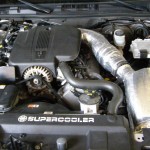
In the past few months, oil prices have soared from $32 to over $70 per barrel. Americans are being hit with the double whammy of reduced income and increased fuel costs. Many vehicles are built to go fast and built to outlast their warranties. Cars and trucks must outlast their warranties under a wide range of conditions, including extreme heat and cold. Vehicle electronic control units are compromises and not optimized to get the best fuel economy for any one specific drive cycle and weather. This creates an opportunity for a variety of fuel saving aftermarket products.
Aftermarket products and service is big business. In 2007, aftermarket product U.S. sales were $285.5 billion. Sales in the automotive aftermarket (cars and light trucks) totaled $211.4 billion and sales in the heavy duty vehicle aftermarket totaled $74.1 billion. The current recession has caused a modest decrease in revenue; rising fuel costs are now increasing revenue. AAIA
Tommy Guilbeau puts on 35,000 to 40,000 miles a year driving his 2006 Dodge Ram Hemi. Working for R.E. Michael Company, he delivers building air conditioning, boilers and heaters over a wide area. I talked to him while he was on his way to deliveries in Birmingham, Alabama. Tommy uses two after market products that save him thousands of dollars per year by boosting his mileage from 17 mpg to 26 mpg – impressive mileage for a pick-up carrying loads.
How did Tommy Guilbeau save over $2,000 in annual fuel cost? Tommy explained to me that he picked-up one mile per gallon by adding Tornado, a $70 device which is designed to improve air flow to an engine’s combustion chamber. It works with either a carbureted or electronic fuel injected engine. It gets its name because it delivers air in a vortex, instead of static air flow.
Tommy said that he gained a massive 7 mpg by installing Supercooler – a $699 device that improves mileage by delivering cooler air to the engine’s combustion chamber. Supercooler includes a thermal jacket installed around the vehicle’s air conditioning systems accumulator. Supercooler’s patented system also includes a liquid coolant, ColdPump, and IceBox. Supercooler installed his system in one day. Tommy stated, “Supercooler is great, especially if you do a lot of freeway driving.”
Products like Supercooler can save thousands per vehicle annually if you are located in a hot climate where the air conditioning is running most of time. If you are located in a colder northern climate, it may not pay for itself.
Aftermarket products are not for everyone. People with new vehicles are concerned that automakers will not honor warranties if they see ad-on products. Fleets with trained mechanics are more comfortable installing and maintaining the devices. Individuals often want experienced mechanics to install and set-up devices.
Many drivers would prefer to adjust vehicle characteristics for fuel economy, rather than acceleration, or for towing when they never tow. The new 2010 Prius, let’s drivers pick on of three settings. Most vehicles offer no choices, so drivers are attracted to aftermarket products.
Chris Fitch has been dealing with accessories for years. Chris sees big mileage gains with chips and software that give more control to drivers. He recommends products like Bully Dog, Superchip, and Hypertech. These devices let you set your performance/mileage preferences, get more data from gauges, allow fleet managers to download data, and give drivers realtime feedback to improve mileage. Devices are available for a range of gasoline and diesel cars, SUVs, and trucks. Many devices reprogram your vehicles computers to better mileage or performance settings. For warranty work, some can reprogram to manufacturer defaults and be removed.
Living in Florida, Chris always uses air conditioning and has Supercooler installed on his 2006 Toyota Tundra Force V8. His mileage took a 25 percent hit, when his girl friend ran the truck without running the air conditioning and therefore not running Supercooler. Chris states that his weekly gas savings pays for the system in months.
Only some aftermarket products boost mileage. Other products are for performance, looks, and convenience. Many products have not been put through rigorous testing on the same drive cycle under the same conditions as unmodified vehicles to verify improvement claims. Fleet managers can test one modified vehicle with an aftermarket product for a period of time, before installing the product on a larger percentage of the fleet. For individuals, aftermarket products are often leaps of faith.
One vehicle expert told me, “I find this hard to believe without certified test data. All this stuff reminds me of PT Barnum. It will most certainly void the OEM warranty unless the manufacturer has approved the device and installation.” An even bigger concern is that some of these devices are illegal in some states without EPA and ARB certification.
Yet it is hard to believe that the $285 billion per year spent on aftermarket products is all wasted money. This article does not begin to cover all the alternative products for boosting mileage, nor when they get results. It does demonstrate that fleets and individuals do not always settle for generic vehicles when a big part of their budget – fuel costs – gets hit. From tuners to tires, programmers to plug-in hybrid conversion kits, from cold air to exhaust heat, fleet managers are using hardware and software to go farther with less money.
As gasoline and diesel prices gyrate upwards and fuel budgets run on empty, more drivers and fleet managers are taking charge of engine performance to meet their specific duty cycles, hauling and cargo weight demands, and take advantage of local temperatures.
